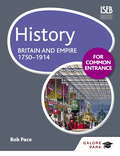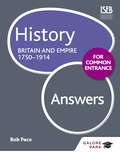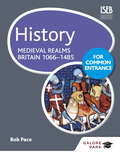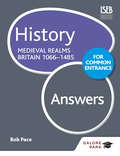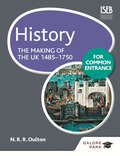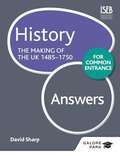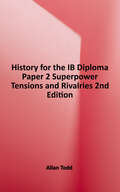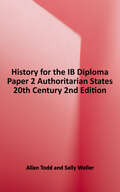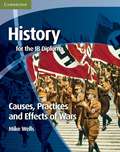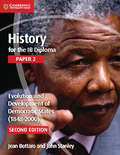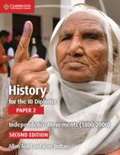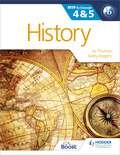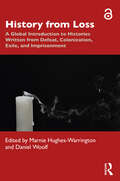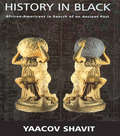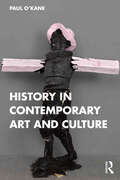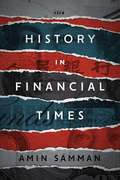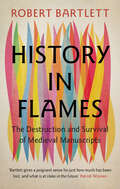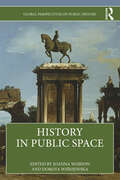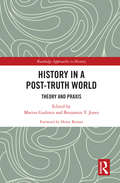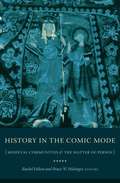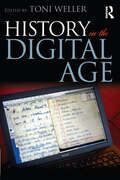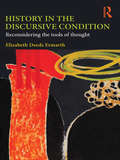- Table View
- List View
History for Common Entrance: Britain and Empire 1750-1914
by Bob PaceHistory for Common Entrance: Britain and Empire 1750-1914 ensures a thorough understanding of the 'Britain and Empire' element of the Common Entrance exam syllabus. Clearly presented content, lively illustrations and challenging end-of-chapter questions encourage learning and inspire a love of History. - Endorsed by ISEB - Written by the chief exam setter for ISEB History Common Entrance - Arranged chronologically, to help pupils understand historical context - Includes source-based questions to develop essential exam skills Answer book available separately. See History for Common Entrance: Britain and Empire 1750-1914 Answers Also available from Galore Park www.galorepark.co.uk: History for Common Entrance 13+ Exam Practice Questions History for Common Entrance 13+ Exam Practice Answers History for Common Entrance 13+ Revision Guide History for Common Entrance: Medieval Realms Britain 1066-1485 History for Common Entrance: The Making of the UK 1485-1750 History for Common Entrance: Britain and Empire 1750-1914
History for Common Entrance: Britain and Empire 1750-1914 Answers
by Bob PaceThis book contains answers to all questions featured in the accompanying textbook History for Common Entrance: Britain and Empire 1750-1914, which ensures a thorough understanding of the 'Britain and Empire' element of the Common Entrance exam syllabus. - Endorsed by ISEB - Corresponds to chronological order of textbook - Features example answers for marking guidance - Includes ISEB Common Entrance mark scheme Also available from Galore Park www.galorepark.co.uk: History for Common Entrance 13+ Exam Practice Questions History for Common Entrance 13+ Exam Practice Answers History for Common Entrance 13+ Revision Guide History for Common Entrance: Medieval Realms Britain 1066-1485 History for Common Entrance: The Making of the UK 1485-1750 History for Common Entrance: Britain and Empire 1750-1914
History for Common Entrance: Medieval Realms Britain 1066-1485
by Bob PaceHistory for Common Entrance: Medieval Realms Britain 1066-1485 ensures a thorough understanding of the 'Medieval Realms' element of the Common Entrance exam syllabus. Clearly presented content, lively illustrations and challenging end-of-chapter questions encourage learning and inspire a love of History. - Endorsed by ISEB - Written by the chief exam setter for ISEB History Common Entrance - Arranged chronologically, to help pupils understand historical context - Includes source-based questions to develop essential exam skills Answer book available separately. See History for Common Entrance: Britain and Empire 1066-1485 Answers Also available from Galore Park www.galorepark.co.uk: History for Common Entrance 13+ Exam Practice Questions History for Common Entrance 13+ Exam Practice Answers History for Common Entrance 13+ Revision Guide History for Common Entrance: Medieval Realms Britain 1066-1485 History for Common Entrance: The Making of the UK 1485-1750 History for Common Entrance: Britain and Empire 1750-1914
History for Common Entrance: Medieval Realms Britain 1066-1485 Answers
by Bob PaceThis book contains answers to all questions featured in the accompanying textbook History for Common Entrance: Medieval Realms Britain 1066-1485, which ensures a thorough understanding of the 'Medieval Realms' element of the Common Entrance exam syllabus. - Endorsed by ISEB - Corresponds to chronological order of textbook - Features example answers for marking guidance - Includes ISEB Common Entrance mark scheme Also available from Galore Park www.galorepark.co.uk: History for Common Entrance 13+ Exam Practice Questions History for Common Entrance 13+ Exam Practice Answers History for Common Entrance 13+ Revision Guide History for Common Entrance: The Making of the UK 1485-1750 History for Common Entrance: Britain and Empire 1750-1914
History for Common Entrance: The Making of the UK 1485-1750
by Bob PaceHistory for Common Entrance: The Making of the UK 1485-1750 ensures a thorough understanding of the 'Making of the UK' element of the Common Entrance exam syllabus. Clearly presented content, lively illustrations and challenging end-of-chapter questions encourage learning and inspire a love of History. - Endorsed by ISEB - Written by the chief exam setter for ISEB History Common Entrance - Arranged chronologically, to help pupils understand historical context - Includes source-based questions to develop essential exam skills Answer book available separately. See History for Common Entrance: Britain and Empire 1485-1750 Answers Also available from Galore Park www.galorepark.co.uk: History for Common Entrance 13+ Exam Practice Questions History for Common Entrance 13+ Exam Practice Answers History for Common Entrance 13+ Revision Guide History for Common Entrance: Medieval Realms Britain 1066-1485 History for Common Entrance: Britain and Empire 1750-1914
History for Common Entrance: The Making of the UK 1485-1750 Answers
by Bob PaceThis book contains answers to all questions featured in the accompanying textbook History for Common Entrance: The Making of the UK 1485-1750, which ensures a thorough understanding of the 'Making of the UK' element of the Common Entrance exam syllabus. - Endorsed by ISEB - Corresponds to chronological order of textbook - Features example answers for marking guidance - Includes ISEB Common Entrance mark scheme Also available from Galore Park www.galorepark.co.uk: History for Common Entrance 13+ Exam Practice Questions History for Common Entrance 13+ Exam Practice Answers History for Common Entrance 13+ Revision Guide History for Common Entrance: Medieval Realms Britain 1066-1485 History for Common Entrance: The Making of the UK 1485-1750 History for Common Entrance: Britain and Empire 1750-1914
History for Tomorrow: Inspiration from the Past for the Future of Humanity
by Roman Krznaric'Brimming with ideas and insights, this is a welcome, important and clear-eyed view of how understanding the past can help us better prepare for the future' - Peter Frankopan, bestselling author of The Earth Transformed and The Silk Roads'Enlightening and thrilling. History for Tomorrow tells us who we are and who we could be' - George Monbiot, bestselling author of Regenesis and How Did We Get Into This Mess?What can humankind’s rich history of radical revolts teach us about the power of disobedience to tackle the climate crisis? What inspiration could we take from eighteenth century Japan to create a regenerative economy today? How might understanding the origins of capitalism spark ideas for bringing AI under control?In History for Tomorrow, leading social philosopher Roman Krznaric unearths fascinating insights and inspiration from the last 1000 years of world history that could help us confront the most urgent challenges facing humanity in the twenty-first century. From bridging the inequality gap and reducing the risks of genetic engineering, to reviving our faith in democracy and avoiding ecological collapse, History for Tomorrow shows that history is not simply a means of understanding the past but a way of reimagining our relationship with the future. Krznaric reveals how, time and again, societies have risen up, often against the odds, to tackle challenges and overcome crises. History offers a vision of radical hope that could turn out to be our most vital tool for surviving and thriving in the turbulent decades ahead.
History for the IB Diploma The Cold War: Superpower Tensions and Rivalries, 2nd Edition (IB Diploma Ser.)
by Allan ToddComprehensive second editions of History for the IB Diploma Paper 2, revised for first teaching in 2015. This coursebook covers Paper 2, World History Topic 12: The Cold War: Superpower Tensions and Rivalries (20th century) of the History for the IB Diploma syllabus for first assessment in 2017. Tailored to the requirements of the IB syllabus and written by experienced IB History examiners and teachers, it offers authoritative and engaging guidance through the following detailed studies of leaders and crises from around the world: Truman, Khrushchev, Gorbachev, Castro, and Reagan; and the Cuban Missile Crisis, the Korean War, the Prague spring, and the Soviet invasion of Afghanistan.
History for the IB Diploma. Paper 2. Authoritarian States. (Ib Diploma Ser.)
by Sally Waller Allan ToddComprehensive second editions of history for the IB Diploma Paper 2, revised for first teaching in 2015. This course book covers Paper 2, World History topic 10: authoritarian states (20th century) of the history for the IB Diploma syllabus for the first assessment in 2017. Tailored to the requirements of the IB syllabus and written by experienced IB history examiners and teachers, it offers authoritative and engaging guidance through the following detailed studies from around the world: Mussolini and Italy, Hitler and Germany, Mao and China, and Castro and Cuba.
History for the IB Diploma: Causes, Practices and Effects of Wars
by Mike WellsAn exciting new series that covers the five Paper 2 topics of the IB 20th Century World History syllabus. This coursebook covers Paper 2, Topic 1, Causes, practices and effects of wars, in the 20th Century World History syllabus for the IB History programme. It is divided into thematic sections, following the IB syllabus structure and is written in clear, accessible English. It covers the following areas for detailed study: First World War (1914-18); Second World War (1939-45); Asia and Oceania: Chinese Civil War (1927-37 and 1946-9); and Europe and Middle East: Spanish Civil War (1936-9). Tailored to the requirements and assessment objectives of the IB syllabus, it allows students to make comparisons between different regions and time periods.
History for the IB Diploma: Evolution and Development of Democratic States (1848-2000)
by Jean Bottaro and John StanleyThis coursebook with Cambridge Elevate edition covers Paper 2, World History Topic 9: Evolution and Development of Democratic States (1848-2000) of the History for the IB Diploma syllabus for first assessment in 2017. Tailored to the requirements of the IB syllabus and written by experienced IB History examiners and teachers, it offers authoritative and engaging guidance through the following detailed studies from around the world: South Africa, India, Germany, and the USA.
History for the IB Diploma: Independence Movements (1800-2000)
by Allan Todd Jean BottaroThis book is designed to prepare students taking the Paper 2 topic World History Topic 8: Independence movements (1800-2000) in the IB History examination. It will examine themes relating to independence movements in Africa and the Middle East, Asia, the Americas and Europe. The themes are organised within chapters focusing on case studies across these regions.
History for the IB MYP 4 & 5: By Concept (MYP By Concept)
by Jo Thomas Keely RogersThe only series for MYP 4 and 5 developed in cooperation with the International Baccalaureate (IB)Develop your skills to become an inquiring learner; ensure you navigate the MYP framework with confidence using a concept-driven and assessment-focused approach presented in global contexts.- Develop conceptual understanding with key MYP concepts and related concepts at the heart of each chapter.- Learn by asking questions with a statement of inquiry in each chapter. - Prepare for every aspect of assessment using support and tasks designed by experienced educators.- Understand how to extend your learning through research projects and interdisciplinary opportunities.This title is also available in two digital formats via Dynamic Learning. Find out more by clicking on the links at the top of the page.Jo Thomas has been Head of History at the following IB schools: Munich International School, United World College of South East Asia (UWCSEA) and the British School of Brussels. Keely Rogers has been HOD and/or teacher of History at the following IB schools: United World College of South East Asia (UWCSEA), the International School of Brussels (ISB) and ACS Egham International School in Surrey, UK.Jo and Keely have written several textbooks for the IB diploma. They are also examiners and workshop leaders for the IB.
History for the IB MYP 4 & 5: By Concept (MYP By Concept)
by Jo Thomas Keely RogersThe only series for MYP 4 and 5 developed in cooperation with the International Baccalaureate (IB)Develop your skills to become an inquiring learner; ensure you navigate the MYP framework with confidence using a concept-driven and assessment-focused approach presented in global contexts.- Develop conceptual understanding with key MYP concepts and related concepts at the heart of each chapter.- Learn by asking questions with a statement of inquiry in each chapter. - Prepare for every aspect of assessment using support and tasks designed by experienced educators.- Understand how to extend your learning through research projects and interdisciplinary opportunities.This title is also available in two digital formats via Dynamic Learning. Find out more by clicking on the links at the top of the page.Jo Thomas has been Head of History at the following IB schools: Munich International School, United World College of South East Asia (UWCSEA) and the British School of Brussels. Keely Rogers has been HOD and/or teacher of History at the following IB schools: United World College of South East Asia (UWCSEA), the International School of Brussels (ISB) and ACS Egham International School in Surrey, UK.Jo and Keely have written several textbooks for the IB diploma. They are also examiners and workshop leaders for the IB.
History from Loss: A Global Introduction to Histories written from defeat, colonization, exile, and imprisonment
by Marnie Hughes-Warrington Daniel WoolfHistory from Loss challenges the common thought that "history is written by the winners" and explores how history-makers in different times and places across the globe have written histories from loss, even when this has come at the threat to their own safety. A distinguished group of historians from around the globe offer an introduction to different history-makers’ lives and ideas, and important extracts from their works which highlight various meanings of loss: from physical ailments to social ostracism, exile to imprisonment, and from dispossession to potential execution. Throughout the volume consideration of the information "bubbles" of different times and places helps to show how information has been weaponized to cause harm. In this way, the text helps to put current debates about the biases and weaponization of platforms such as social media into global and historical perspectives. In combination, the chapters build a picture of history from loss which is global, sustained, and anything but a simple mirror of history made by victors. The volume also includes an Introduction and Afterword, which draw out the key meanings of history from loss and which offer ideas for further exploration. History from Loss provides an invaluable resource for students, teachers, and general readers who wish to put current debates on bias, the politicization of history, and threats to history-makers into global and historical perspectives. The Open Access version of this book, available at www.taylorfrancis.com, has been made available under a Creative Commons Attribution-Non Commercial-No Derivatives 4.0 license.
History in Black: African-Americans in Search of an Ancient Past
by Yaacov ShavitThe development of Afrocentric historical writing is explored in this study which traces this recording of history from the Hellenistic-Roman period to the 19th century. Afrocentric writers are depicted as searching for the unique primary source of "culture" from one period to the next. Such passing on of cultural traits from the "ancient model" from the classical period to the origin of culture in Egypt and Africa is shown as being a product purely of creative history.
History in Contemporary Art and Culture
by Paul O'KaneThis unique book offers guidance for contemporary art practices in dialogue with history, story, memory, and tradition. Artist and lecturer Paul O’Kane uses innovative and creative means, informed by a storytelling tradition as well as academic research, to make connections between contemporary art, history, and the past. The aim of this book is to give readers a sense of the profundity of historical questions, while making the challenge inviting, welcoming and manageable. It is designed to set out an expansive, inclusive and diverse range of potential directions, and speculations from which students can develop personal paths of enquiry. This is achieved by writing and designing the text in an accessible way and providing a range of ‘ways-in’. A series of carefully chosen references, examples, key texts, and possible essay questions are chosen and pitched at various levels and can be close-read, discussed, digested, and responded to either verbally or in the form of a presentation or essay. Written primarily for a broad range of fine arts students, this book encourages readers to reconsider their studies and art practices in light of a historical perspective, enhanced by creative contributions from artists, imaginative philosophers, and influential cultural commentators.
History in Financial Times (Currencies: New Thinking for Financial Times)
by Amin SammanCritical theorists of economy tend to understand the history of market society as a succession of distinct stages. This vision of history rests on a chronological conception of time whereby each present slips into the past so that a future might take its place. This book argues that the linear mode of thinking misses something crucial about the dynamics of contemporary capitalism. Rather than each present leaving a set past behind it, the past continually circulates through and shapes the present, such that historical change emerges through a shifting panorama of historical associations, names, and dates. The result is a strange feedback loop between now and then, real and imaginary. Demonstrating how this idea can give us a better purchase on financial capitalism in the post-crisis era, History in Financial Times traces the diverse modes of history production at work in the spheres of financial journalism, policymaking, and popular culture. Paying particular attention to narrative and to notions of crisis, recurrence, and revelation, Amin Samman gives us a novel take on the relation between historical thinking and critique.
History in Flames: The Destruction and Survival of Medieval Manuscripts
by Robert BartlettTo what extent does our knowledge of the past rely upon written sources? And what happens when these sources are destroyed? Focusing on the manuscripts of the Middle Ages, History in Flames explores cases in which large volumes of written material were destroyed during a single day. This destruction didn't occur by accident of fire or flood but by human forces such as arson, shelling and bombing. This book examines the political and military events that preceded the moment of destruction, from the Franco-Prussian War and the Irish Civil War to the complexities of World War II; it analyses the material lost and how it came to be where it was. At the same time, it discusses the heroic efforts made by scholars and archivists to preserve these manuscripts, even partially. History in Flames reminds us that historical knowledge rests on material remains, and that these remains are vulnerable.
History in Public Space (Global Perspectives on Public History)
by Joanna Wojdon Dorota WiśniewskaThis book focuses on various manifestations of history in public spaces: in the physical ones of various historical times and geographical places, as well as in the virtual world.It discusses how the spaces have been shaped and re-shaped, by whom and for what (not always laudable) purposes, and raises pragmatical and ethical questions for both research and practical activities in the field. By combining both micro and global perspectives, the universal role that history plays in spaces created by and for, as well as the factors determining its usages, is revealed. The authors are rooted in specific national contexts: Canadian or American, Ukrainian or Polish, British or Irish, German or Luxembourgish, Korean or Brazilian, and the case studies are varied including large cities and small towns, city centers, and godforsaken cemeteries, but the narratives built on these cases go beyond when they deal with issues such as decoding history and its meanings in public spaces, doing history in public spaces, and observing changes in manifestations of history in public spaces.This volume is an essential resource for anyone interested in the relationship between history and public space in a global perspective.
History in a Post-Truth World: Theory and Praxis (Routledge Approaches to History #39)
by Benjamin T. Jones Marius GudonisHistory in a Post-Truth World: Theory and Praxis explores one of the most significant paradigm shifts in public discourse. A post-truth environment that appeals primarily to emotion, elevates personal belief, and devalues expert opinion has important implications far beyond Brexit or the election of Donald Trump, and has a profound impact on how history is produced and consumed. Post-truth history is not merely a synonym for lies. This book argues that indifference to historicity by both the purveyor and the recipient, contempt for expert opinion that contradicts it, and ideological motivation are its key characteristics. Taking a multidisciplinary approach, this work explores some of the following questions: What exactly is post-truth history? Does it represent a new phenomenon? Does the historian have a special role to play in preserving public memory from ‘alternative facts’? Do academics more generally have an obligation to combat fake news and fake history both in universities and on social media? How has a ‘post-truth culture’ impacted professional and popular historical discourse? Looking at theoretical dimensions and case studies from around the world, this book explores the violent potential of post-truth history and calls on readers to resist.
History in the Comic Mode: Medieval Communities and the Matter of Person
by Fulton Rachel Bruce W. HolsingerTwenty-one prominent medievalists discuss continuity and change in ideas of personhood and community and argue for the viability of the comic mode in the study and recovery of history.
History in the Comic Mode: Medieval Communities and the Matter of Person
by Fulton Rachel Bruce W. Holsinger Eds.In this groundbreaking collection, twenty-one prominent medievalists discuss continuity and change in ideas of personhood and community and argue for the viability of the comic mode in the study and recovery of history. These scholars approach their sources not from a particular ideological viewpoint but with an understanding that all topics, questions, and explanations are viable. They draw on a variety of sources in Latin, Arabic, French, German, Middle English, and more, and employ a range of theories and methodologies, always keeping in mind that environments are inseparable from the making of the people who inhabit them and that these people are in part constituted by and understood in terms of their communities. Essays feature close readings of both familiar and lesser known materials, offering provocative interpretations of John of Rupescissa's alchemy; the relationship between the living and the saintly dead in Bernard of Clairvaux's sermons; the nomenclature of heresy in the early eleventh century; the apocalyptic visions of Robert of Uzès; Machiavelli's De principatibus; the role of "demotic religiosity" in economic development; and the visions of Elizabeth of Schönau. Contributors write as historians of religion, art, literature, culture, and society, approaching their subjects through the particular and the singular rather than through the thematic and the theoretical. Playing with the wild possibilities of the historical fragments at their disposal, the scholars in this collection advance a new and exciting approach to writing medieval history.
History in the Digital Age
by Toni WellerThe digital age is affecting all aspects of historical study, but much of the existing literature about history in the digital age can be alienating to the traditional historian who does not necessarily value or wish to embrace digital resources. History in the Digital Age takes a more conceptual look at how the digital age is affecting the field of history for both scholars and students. The printed copy, the traditional archive, and analogue research remain key constitute parts for most historians and for many will remain precious and esteemed over digital copies, but there is a real need for historians and students of history to seriously consider some of the conceptual and methodological challenges facing the field of historical enquiry as we enter the twenty-first century. Including international contributors from a variety of disciplines - History, English, Information Studies and Archivists – this book does not seek either to applaud or condemn digital technologies, but takes a more conceptual view of how the field of history is being changed by the digital age. Essential reading for all historians.
History in the Discursive Condition: Reconsidering the Tools of Thought
by Elizabeth Deeds ErmarthIn this bold new book, Elizabeth Deeds Ermarth traces the broadly established challenges to modernity that now confront historians and citizens of Western societies generally. She puts forward a clear definition of both The Modern Condition and of The Discursive Condition that challenges it, and she briefly introduces the most important practical implications of those challenges to accepted definitions and tools of thought. After decades of conflicting work on related issues this book provides a succinct, lucid and wide-ranging discussion of what is at stake. Drawing on a broad range of intellectual and cultural history from Homer to Hayden White and from the arts to physics, philosophy and politics, this book defines a new stage in the history of ideas. With the practice and assumptions of historians at its core, the book demonstrates the importance of interdisciplinary practice in addressing the big questions currently confronting the humanities and social sciences.
